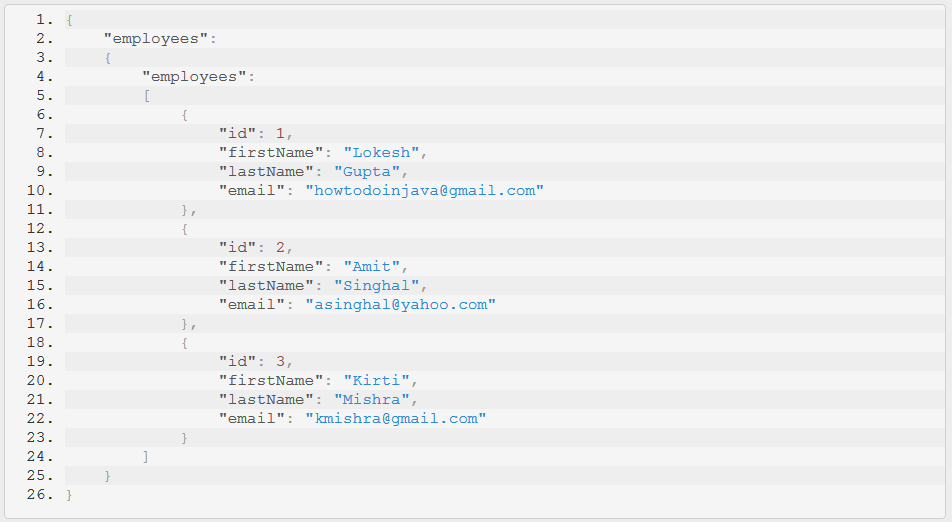1) Using @ResponseBody Annotation
This technique is simple and easy. You have to include only jackson dependencies into classpath of your application and spring will register Jackson2JsonMessageConverter class automatically into context. Whenever you ask for a resource from REST API and provide http header “accept: application/json“, you will get back the json representation of resource.
Runtime JSON dependency
<!-- Jackson JSON Processor -->
<dependency>
<groupId>com.fasterxml.jackson.core</groupId>
<artifactId>jackson-databind</artifactId>
<version>2.4.1</version>
</dependency>@ResponseBody Support
Here @RestController = @Controller + @ResponseBody
@RestController
public class EmployeeRESTController
{
@RequestMapping(value = "/employees")
public EmployeeListVO getAllEmployees()
{
EmployeeListVO employees = new EmployeeListVO();
EmployeeVO empOne = new EmployeeVO(1,"Lokesh","Gupta","howtodoinjava@gmail.com");
EmployeeVO empTwo = new EmployeeVO(2,"Amit","Singhal","asinghal@yahoo.com");
EmployeeVO empThree = new EmployeeVO(3,"Kirti","Mishra","kmishra@gmail.com");
employees.getEmployees().add(empOne);
employees.getEmployees().add(empTwo);
employees.getEmployees().add(empThree);
return employees;
}
@RequestMapping(value = "/employees/{id}")
public ResponseEntity<EmployeeVO> getEmployeeById (@PathVariable("id") int id)
{
if (id <= 3) {
EmployeeVO employee = new EmployeeVO(1,"Lokesh","Gupta","howtodoinjava@gmail.com");
return new ResponseEntity<EmployeeVO>(employee, HttpStatus.OK);
}
return new ResponseEntity(HttpStatus.NOT_FOUND);
}
}2) Using MappingJackson2JsonView Support
The MappingJackson2JsonView class also depends on the presence of the Jackson JSON processor library in classpath, so you don’t need to add anything extra. Complete pom.xml looks like this:
pom.xml
<project xmlns="http://maven.apache.org/POM/4.0.0" xmlns:xsi="http://www.w3.org/2001/XMLSchema-instance"
xsi:schemaLocation="http://maven.apache.org/POM/4.0.0 http://maven.apache.org/maven-v4_0_0.xsd">
<modelVersion>4.0.0</modelVersion>
<groupId>com.howtodoinjava.demo</groupId>
<artifactId>springrestexample</artifactId>
<packaging>war</packaging>
<version>0.0.1-SNAPSHOT</version>
<name>springrestexample Maven Webapp</name>
<url>http://maven.apache.org</url>
<dependencies>
<dependency>
<groupId>junit</groupId>
<artifactId>junit</artifactId>
<version>4.12</version>
<scope>test</scope>
</dependency>
<!-- Spring MVC support -->
<dependency>
<groupId>org.springframework</groupId>
<artifactId>spring-webmvc</artifactId>
<version>4.1.4.RELEASE</version>
</dependency>
<dependency>
<groupId>org.springframework</groupId>
<artifactId>spring-web</artifactId>
<version>4.1.4.RELEASE</version>
</dependency>
<dependency>
<groupId>org.springframework</groupId>
<artifactId>spring-core</artifactId>
<version>4.1.4.RELEASE</version>
</dependency>
<!-- Jackson JSON Processor -->
<dependency>
<groupId>com.fasterxml.jackson.core</groupId>
<artifactId>jackson-databind</artifactId>
<version>2.4.1</version>
</dependency>
</dependencies>
<build>
<finalName>springrestexample</finalName>
</build>
</project>2) Adding MappingJackson2JsonView view
When you are using MappingJackson2JsonView class, you will need to return a view name of type MappingJackson2JsonView. So you will need to change two places.
a) Controller change
You will need to return viewName from controller method. In our case, view name is “jsonTemplate“.
“`
package com.howtodoinjava.demo.controller;
import org.springframework.http.HttpStatus;
import org.springframework.http.MediaType;
import org.springframework.http.ResponseEntity;
import org.springframework.stereotype.Controller;
import org.springframework.ui.Model;
import org.springframework.web.bind.annotation.PathVariable;
import org.springframework.web.bind.annotation.RequestMapping;
import com.howtodoinjava.demo.model.EmployeeListVO;
import com.howtodoinjava.demo.model.EmployeeVO;
@Controller
public class EmployeeRESTController
{
private EmployeeListVO getEmployeesCollection()
{
EmployeeListVO employees = new EmployeeListVO();
EmployeeVO empOne = new EmployeeVO(1,"Lokesh","Gupta","howtodoinjava@gmail.com");
EmployeeVO empTwo = new EmployeeVO(2,"Amit","Singhal","asinghal@yahoo.com");
EmployeeVO empThree = new EmployeeVO(3,"Kirti","Mishra","kmishra@gmail.com");
employees.getEmployees().add(empOne);
employees.getEmployees().add(empTwo);
employees.getEmployees().add(empThree);
return employees;
}
@RequestMapping(value = "/employees")
public String getAllEmployeesJSON(Model model)
{
model.addAttribute("employees", getEmployeesCollection());
return "jsonTemplate";
}
}
““
b) Configuration Change
You will need to configure viewName “jsonTemplate” as bean of type MappingJackson2JsonView. And you will need to configure view resolver of type BeanNameViewResolver. This way viewName “jsonTemplate” will be matched with MappingJackson2JsonView and parsed JSON response will be returned to client.
RESTConfiguration.java
@Configuration
public class RESTConfiguration
{
@Bean
public View jsonTemplate() {
MappingJackson2JsonView view = new MappingJackson2JsonView();
view.setPrettyPrint(true);
return view;
}
@Bean
public ViewResolver viewResolver() {
return new BeanNameViewResolver();
}
}Equivalent XML configuration to above java configuration is as below.
spring-servlet.xml
<beans xmlns="http://www.springframework.org/schema/beans"
xmlns:xsi="http://www.w3.org/2001/XMLSchema-instance" xmlns:context="http://www.springframework.org/schema/context"
xmlns:mvc="http://www.springframework.org/schema/mvc"
xsi:schemaLocation="http://www.springframework.org/schema/beans http://www.springframework.org/schema/beans/spring-beans.xsd
http://www.springframework.org/schema/context http://www.springframework.org/schema/context/spring-context.xsd
http://www.springframework.org/schema/mvc http://www.springframework.org/schema/mvc/spring-mvc.xsd">
<context:component-scan base-package="com.howtodoinjava.demo" />
<mvc:annotation-driven />
<!-- JSON Support -->
<bean name="viewResolver" class="org.springframework.web.servlet.view.BeanNameViewResolver"/>
<bean name="jsonTemplate" class="org.springframework.web.servlet.view.json.MappingJackson2JsonView"/>
</beans>3) Test Changes
Now when you hit the URL : http://localhost:8080/springrestexample/employees , you will get this result.
























 1万+
1万+











 被折叠的 条评论
为什么被折叠?
被折叠的 条评论
为什么被折叠?








